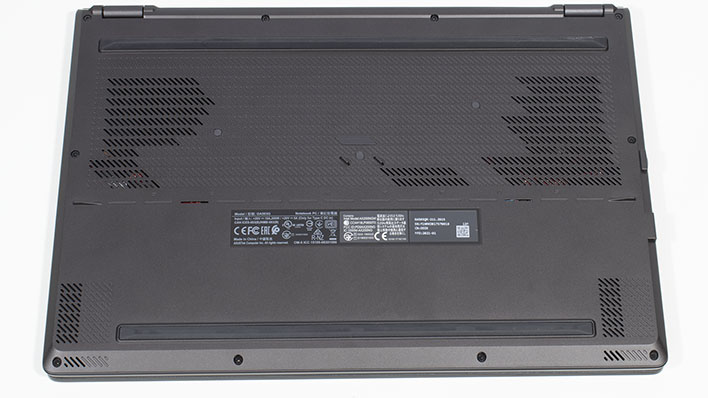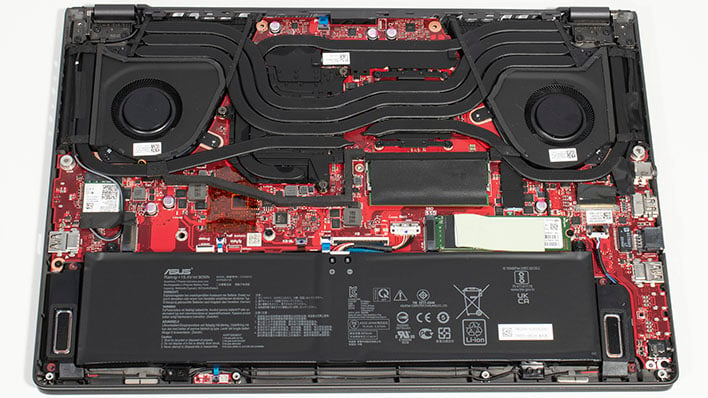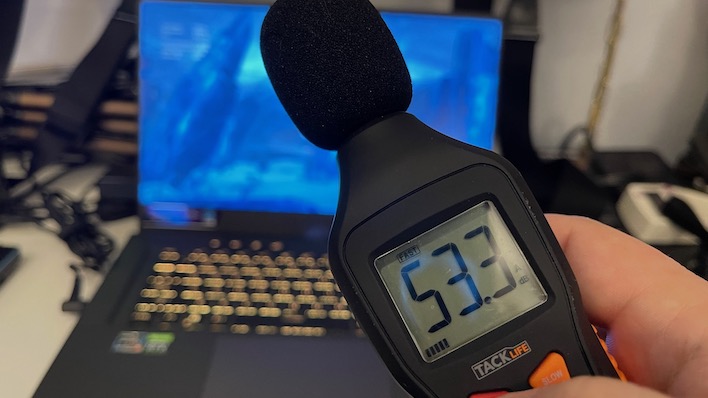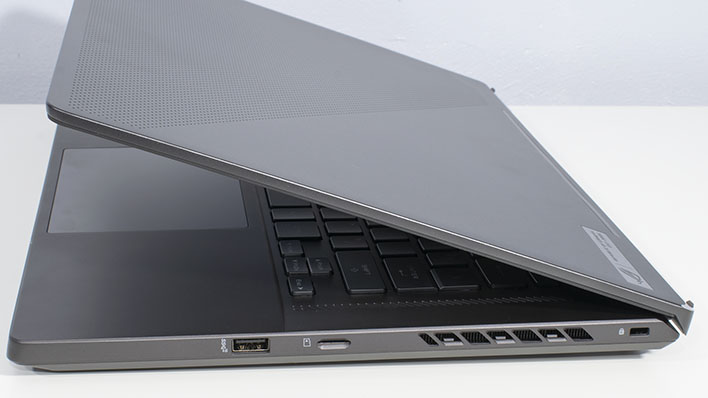ASUS ROG Zephyrus G15 Review: A Mighty Zen 3 Gaming Laptop
ASUS ROG Zephyrus G15: Teardown, Thermals And Review Conclusion
Next up we're going to take a look inside the ASUS ROG Zephyrus G15 to see what its user upgrade options and cooling design are like. But first, here's a good look at the bottom of the unit, which has vents in several places. At the front of the machine on the far sides, we have speaker output grilles. Towards the back (or top, in this photo) we have much bigger openings for ventilation. The system draws cool air in from the bottom, aided by the system's ErgoLift hinge design when the lid is open, and expels the hot air through the vents we saw earlier between the body and display bezel.
Under the hood, we can see several user-upgradeable parts and an intricate cooling system. There are no fewer than six heat pipes that draw heat from the Ryzen 9 5900HS and the GeForce RTX 3070 mobile GPU. That heat then routes to a pair of fin arrays cooled by twin blower fans. Most of the air exhausts out the rear of the system, although there are vents on each side of the notebook as well. The cooler appears to be all one single unit, so the CPU and GPU share the system's combined cooling capacity. This explains why Turbo mode didn't do much for CPU-only tasks, but helped quite a bit when gaming.
ASUS allows user upgrades in several ways. First and foremost, a single DDR4-3200 SODIMM sits beneath a black plastic sheet near the CPU. This is the only available SO-DIMM slot, as the remainder of the RAM is soldered to the motherboard. This gives the system dual-channel memory, but if we were to upgrade from the stock 8 GB SO-DIMM to 16 or 32 GB, we'd have an asymmetrical memory load out. It's better than nothing, and a far sight better than the soldered-only options on the recently reviewed Alienware m15 R4.
ASUS also built a pair of M.2 slots into the Zephyrus, with one filled with the 1 TB SSD. Adding a second is a snap, as ASUS includes the screw required to mount the drive in the notebook. Even the Wi-Fi NIC module is user-serviceable, as it sits on the left side near the USB ports in the photo above. The battery can also be easily replaced by pulling a couple connectors and removing a couple of screws. ASUS outfitted the notebook with a 90Wh battery, which contributed to its very solid general use battery life.
To get the system up to load, we looped the Gears 5 built-in benchmark using the same 1080p resolution and High graphics preset from our tests. We then fired up HWMonitor and pulled out our trusty laser thermometer and sound meter. Temperatures didn't really change between the default Windows power profile and ASUS's Turbo mode, either on the surface or internally. The Ryzen 9 5900HS CPU held steady at 93°C while the GeForce RTX 3070 settled in at 83°C. Both of those are within spec for the respective chips, so there's no problem here. The surface temperature was at its hottest near the hinges at the rear, where we saw the vents in the teardown. While the system was warm to the touch, 117°F (47°C) isn't too bad, considering the location.
The difference in performance we observed seems to be entirely due to the difference in fan speeds at whatever performance profile you select. Using the default profile, the fans spun up to audible levels but not to the point of that whine we mentioned earlier. We used our sound meter to measure noise at around the spot our ears would be while gaming normally, which is around 22 to 24 inches from the center of the display. The loudest the system got at default was 48 dBA, which is audible but still pretty tame. With the Turbo profile, fan noise kicked up a bit and maxed out at around 52-53 dBA. Despite the relatively close numbers, sound pressure measurements are logarithmic and as a result, the system was around 50% louder in perceived noise, based on the decibel scale, as 10 dBA represents a doubling of noise output. All that said, this gaming laptop is really not all that loud, and again, completely masked by a headset or the system's speakers when cranked up and gaming.
What does absolutely scream is its combination of AMD Ryzen 9 5900HS and NVIDIA GeForce RTX 3070 CPU and GPU firepower. In last year's gaming notebooks, virtually all of the AMD-powered systems topped out with GeForce RTX 2060 or Radeon RX 5600M graphics. This year, many notebook manufacturers are fully embracing AMD’s Ryzen 5000 mobile offerings and pairing them with the fastest graphics options around. Add in all the connectivity options and the Zephyrus G15's lightning-fast 165 Hz display panel, and this notebook has all the makings for laptop gaming excellence.
Performance of the Zephyrus G15 was outstanding. Its CPU performance outstrips just about anything that Intel has at the moment, as AMD's Zen 3 architecture has excellent single-threaded performance, while the configuration with eight cores means that the system's multi-threaded prowess is best-of-class. As a result, the ROG Zephyrus G15 was the fastest notebook we tested in a wide variety of CPU-only benchmarks from Geekbench to rendering. Only the lightly-threaded Speedometer web benchmark ran faster on an Intel notebook, and we had to call in Intel's fastest Tiger Lake CPU to achieve that. Everything we did with this notebook was buttery smooth and consumers will have all the horsepower they need on the CPU side.
In games, this notebook lived up to its billing as well. NVIDIA's GeForce RTX 3070 mobile GPU is fast, even with the slimmed-down 80 Watt TGP of this particular machine. The ROG Zephyrus G15 routinely came in second to the Alienware m15 R4, but that notebook gives its GPU the full 125 Watt power budget. Considering the much higher power consumption in that Dell configuration, the Zephyrus G15 still put up an impressive showing. The system routinely eclipsed 100 fps with high detail settings at 1080p in a number of games, and its high refresh rate panel kept pace with the high speed action.
From here, all that's left to discuss is pricing. The ROG Zephyrus G15 GA503 family starts and ends with the Ryzen 9 5900HS, and its various configurations differ in RAM, SSD, and GPU selection. System memory configs start at 16GB and SSD capacity begins at 512GB, while the entry level GPU is a GeForce RTX 3060 with 6 GB of VRAM. The least-expensive model available for sale has 16GB of memory, a 512GB SSD, and that GeForce RTX 3060 for $1,499. Stepping up to a 1 TB SSD and the GeForce RTX 3070 like we tested today pushes the price up to a still reasonable $1,799. Add in the 1440p 165 Hz display, connectivity, and excellent keyboard, and we think the Zephyrus G15 has a solid value proposition.
Meanwhile, the Alienware m15 R4 we tested has a 60 Hz 4K OLED panel and a higher-powered version of the GeForce, but that system runs $2,499. The ASUS notebook has a smaller footprint and lighter weight, making it more portable if not quite as fast. Still, for $700 less, that seems like a fair trade-off making this ASUS option a good deal. There's also the curious absence of a webcam, but that might be a plus to some, and neutral to others who might opt for a nicer external webcam anyway. While its display isn't the brightest, its color accuracy is great and we found its 305 lux output was bright enough in all but direct sunlight conditions.
The Zephyrus G15 is a fast gaming notebook with understated looks and excellent battery life, at a reasonable price point. It used to be that notebooks carried a big premium to afford portability. However, considering the odd times in which we live, where discrete desktop parts are in high demand and routinely sell for more than twice their MSRP, a gaming notebook like the Zephyrus G15 might just be the most economical way to upgrade. Those of you in the market for a speedy, stylish system with great graphics and CPU chops, the ASUS ROG Zephyrus G15 is definitely one to consider.

Under The Hood Of The ASUS ROG Zephyrus G15
Getting into the ROG Zephyrus G15 is pretty straightforward. We have a total of ten visible screws: four on the front, four at the rear, and two on the sides. There are also three hidden screws underneath rubber plugs in the middle. None of them are captive, and they come in several different lengths, so make sure to keep them straight while pulling them from the system. Once the screws are all out of the chassis, it pops off with just a little bit of prying.Under the hood, we can see several user-upgradeable parts and an intricate cooling system. There are no fewer than six heat pipes that draw heat from the Ryzen 9 5900HS and the GeForce RTX 3070 mobile GPU. That heat then routes to a pair of fin arrays cooled by twin blower fans. Most of the air exhausts out the rear of the system, although there are vents on each side of the notebook as well. The cooler appears to be all one single unit, so the CPU and GPU share the system's combined cooling capacity. This explains why Turbo mode didn't do much for CPU-only tasks, but helped quite a bit when gaming.
ASUS allows user upgrades in several ways. First and foremost, a single DDR4-3200 SODIMM sits beneath a black plastic sheet near the CPU. This is the only available SO-DIMM slot, as the remainder of the RAM is soldered to the motherboard. This gives the system dual-channel memory, but if we were to upgrade from the stock 8 GB SO-DIMM to 16 or 32 GB, we'd have an asymmetrical memory load out. It's better than nothing, and a far sight better than the soldered-only options on the recently reviewed Alienware m15 R4.
ASUS also built a pair of M.2 slots into the Zephyrus, with one filled with the 1 TB SSD. Adding a second is a snap, as ASUS includes the screw required to mount the drive in the notebook. Even the Wi-Fi NIC module is user-serviceable, as it sits on the left side near the USB ports in the photo above. The battery can also be easily replaced by pulling a couple connectors and removing a couple of screws. ASUS outfitted the notebook with a 90Wh battery, which contributed to its very solid general use battery life.
Zephyrus G15 (2021) Thermal and Acoustic Performance
At idle, the ROG Zephyrus G15 is a very quiet notebook that didn't register any louder than the noise floor of our ~30 dBA room. Under load, we could hear the fans spin up and push a lot of air, which we could also feel from the vents. When the fans get up to their loudest, there's a hint of a whine to them, but it's not loud enough to be annoying, and certainly undetectable if we played with a headset.To get the system up to load, we looped the Gears 5 built-in benchmark using the same 1080p resolution and High graphics preset from our tests. We then fired up HWMonitor and pulled out our trusty laser thermometer and sound meter. Temperatures didn't really change between the default Windows power profile and ASUS's Turbo mode, either on the surface or internally. The Ryzen 9 5900HS CPU held steady at 93°C while the GeForce RTX 3070 settled in at 83°C. Both of those are within spec for the respective chips, so there's no problem here. The surface temperature was at its hottest near the hinges at the rear, where we saw the vents in the teardown. While the system was warm to the touch, 117°F (47°C) isn't too bad, considering the location.
The difference in performance we observed seems to be entirely due to the difference in fan speeds at whatever performance profile you select. Using the default profile, the fans spun up to audible levels but not to the point of that whine we mentioned earlier. We used our sound meter to measure noise at around the spot our ears would be while gaming normally, which is around 22 to 24 inches from the center of the display. The loudest the system got at default was 48 dBA, which is audible but still pretty tame. With the Turbo profile, fan noise kicked up a bit and maxed out at around 52-53 dBA. Despite the relatively close numbers, sound pressure measurements are logarithmic and as a result, the system was around 50% louder in perceived noise, based on the decibel scale, as 10 dBA represents a doubling of noise output. All that said, this gaming laptop is really not all that loud, and again, completely masked by a headset or the system's speakers when cranked up and gaming.
ASUS ROG Zephyrus G15 Performance And Review Summary
The ASUS Zephyrus G15 is a speedy 4 pound gaming laptop. Externally, it has a beautiful if subtly eye-catching look with its perforated lid hiding its intriguing color-changing film underneath. The Eclipse Gray finish we received for review is devoid of gaudy decorations and wild RGB lighting effects, often found in gaming devices. This machine wouldn't really look all that out of place in a professional environment. The only thing which might betray its gaming capabilities is the RGB-backlit keyboard, and those effects can be disabled or dialed down at the touch of a button. In short, the Zephyrus G15 is quite a looker without screaming for attention.What does absolutely scream is its combination of AMD Ryzen 9 5900HS and NVIDIA GeForce RTX 3070 CPU and GPU firepower. In last year's gaming notebooks, virtually all of the AMD-powered systems topped out with GeForce RTX 2060 or Radeon RX 5600M graphics. This year, many notebook manufacturers are fully embracing AMD’s Ryzen 5000 mobile offerings and pairing them with the fastest graphics options around. Add in all the connectivity options and the Zephyrus G15's lightning-fast 165 Hz display panel, and this notebook has all the makings for laptop gaming excellence.
Performance of the Zephyrus G15 was outstanding. Its CPU performance outstrips just about anything that Intel has at the moment, as AMD's Zen 3 architecture has excellent single-threaded performance, while the configuration with eight cores means that the system's multi-threaded prowess is best-of-class. As a result, the ROG Zephyrus G15 was the fastest notebook we tested in a wide variety of CPU-only benchmarks from Geekbench to rendering. Only the lightly-threaded Speedometer web benchmark ran faster on an Intel notebook, and we had to call in Intel's fastest Tiger Lake CPU to achieve that. Everything we did with this notebook was buttery smooth and consumers will have all the horsepower they need on the CPU side.
In games, this notebook lived up to its billing as well. NVIDIA's GeForce RTX 3070 mobile GPU is fast, even with the slimmed-down 80 Watt TGP of this particular machine. The ROG Zephyrus G15 routinely came in second to the Alienware m15 R4, but that notebook gives its GPU the full 125 Watt power budget. Considering the much higher power consumption in that Dell configuration, the Zephyrus G15 still put up an impressive showing. The system routinely eclipsed 100 fps with high detail settings at 1080p in a number of games, and its high refresh rate panel kept pace with the high speed action.
From here, all that's left to discuss is pricing. The ROG Zephyrus G15 GA503 family starts and ends with the Ryzen 9 5900HS, and its various configurations differ in RAM, SSD, and GPU selection. System memory configs start at 16GB and SSD capacity begins at 512GB, while the entry level GPU is a GeForce RTX 3060 with 6 GB of VRAM. The least-expensive model available for sale has 16GB of memory, a 512GB SSD, and that GeForce RTX 3060 for $1,499. Stepping up to a 1 TB SSD and the GeForce RTX 3070 like we tested today pushes the price up to a still reasonable $1,799. Add in the 1440p 165 Hz display, connectivity, and excellent keyboard, and we think the Zephyrus G15 has a solid value proposition.
Meanwhile, the Alienware m15 R4 we tested has a 60 Hz 4K OLED panel and a higher-powered version of the GeForce, but that system runs $2,499. The ASUS notebook has a smaller footprint and lighter weight, making it more portable if not quite as fast. Still, for $700 less, that seems like a fair trade-off making this ASUS option a good deal. There's also the curious absence of a webcam, but that might be a plus to some, and neutral to others who might opt for a nicer external webcam anyway. While its display isn't the brightest, its color accuracy is great and we found its 305 lux output was bright enough in all but direct sunlight conditions.
The Zephyrus G15 is a fast gaming notebook with understated looks and excellent battery life, at a reasonable price point. It used to be that notebooks carried a big premium to afford portability. However, considering the odd times in which we live, where discrete desktop parts are in high demand and routinely sell for more than twice their MSRP, a gaming notebook like the Zephyrus G15 might just be the most economical way to upgrade. Those of you in the market for a speedy, stylish system with great graphics and CPU chops, the ASUS ROG Zephyrus G15 is definitely one to consider.

 |
 |
||
|
|












